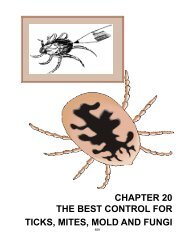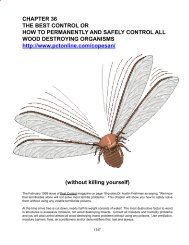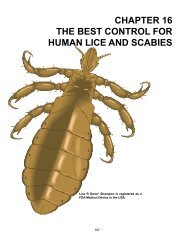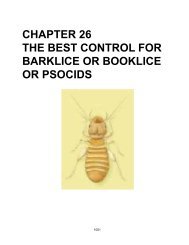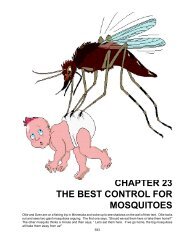Oregano also contains four anti-asthmatic compounds; six compounds that are expectorants; seven that lowerblood pressure; nineteen antibacterial compounds and up to 8.8 percent bactericidal compounds. Loaded withantiseptic compounds, oregano is useful in treating sinusitis; try a tea and inhale as you drink. Make a tea byusing one to two teaspoons of dried oregano per cup of boiling water.According to Heinerman’s Encyclopedia of Fruits, Vegetables and Herbs, Oregano helps reduce fevers andrelieve cramps, bronchitis, childhood diseases such as measles and mumps, and irregular menstruations. Makethis tea: bring a pint of water to a boil. Remove from heat and add one teaspoon of Oregano. Stir well, coverand let steep for about half an hour. Strain and it can be refrigerated. Warming only slightly that amount to beconsumed, one cup two to three times daily.Willpower - <strong>The</strong> opposite of willpower is addiction.Windex ® - kills insects/arachnids quickly, but do a Google search on Windex and danger.Winter Rye - Sow winter rye in the fall, using about 1 pound per 500 square feet. When the rye grows 3 feettall, cut it off at the grouind level and cover the rye grass with cardboard and then cover the cardboard with 1inch of mulch. In several months the rye grass and cardboard should be composted enough to till and plant.Wireworm Spray - Crush wireworms and add some water to make a bug-juice liquid. Strain and spray onaffected crops.Wireworm Traps - Cut fresh potatoes in half and cut out the eyes. Poke a stick into each piece of potato touse as a handle. Early in the season, bury the traps 4-6” deep in the garden or flower bed, before the seedsor tubers are planted, to attract wireworms. Every day, pull out the potatoes, using the sticks as handles, andshake off the wireworms into a bucket of soapy water. Reuse the same potato for a while, then replace with anew one. Use one trap for each square yard of soil.Witch Hazel (Hamamelis virginiana) - will quickly reduce the pain from any insect bite.Wolfsbane or Scorpion Plant (Aconitum anthora) - About 300 B.C.E. <strong>The</strong>ophratus in Book 9 of his Enquiryinto Plants noted this plant kills scorpions if it is shredded over them.Wood Ashes - Sprinkle over bushes and plants - they are caustic and will dehydrate and/or suffocate aphids.Rinse off after a day. Make an application of wood ashes around the base of newly set plants to control maggots,red spiders, aphids and cutworms and to help repel rabbits and deer. A barrier a few inches deep will keep snailsand slugs away. Put the ashes in a box where they will stay dry and poultry can flutter in the ashes to get rid ofparasites. Ashes on ice will provide traction.Wood Fern, Shield Fern (Dryopteris felix-mas) - <strong>The</strong> powdered rhizome is toxic to armyworms.Wood Pallets - Remove them; they can be a source of wood destroying insects and a source of psocids whenthey become wet.Woodpeckers - will eat coddling moth larvae and other pests. Hang shiny strips of aluminum foil or aluminumpans where you want to repel woodpeckers.Woods - Wherever there are woods there will always be a higher water table. Wood also provide birds andbeneficial habitatWool - Loosely wadded sheep wool tied around a stem of a plant will keep leaf cutter ants from crossing over.Wool has also been used as a mulch. <strong>The</strong> natural lanolin in wool repels dust mites.Work - Anothr four-letter word. Don’t just talk the talk; you must walk the walk.Wormseed; Jerusalem Tea (Chenopodium ambrosioides) - Some parts are toxic as extracts or dusts onseveral species of leaf-eating larvae.476
Wormwood (Artemisia absinthium) (a/k/a absinthe, absinthium, green ginger and/or madderwort) - A hardyperennial, 3’ - 5’ with silver-gray, silky foliage and leafy spikes of small flowers. Hardy throughout the U. S. Easyto grow from seeds. Plants repel rabbits. Has many uses as food seasoning and medicinal plant and to controlinternal parasites. Fresh wormwood juice mixed with apple cider vinegar can be used to repel mosquitoes, fliesand other biting insects. Wormwood sprigs will also repel moths and other insects. Powdered dust from theplant sprinkled on plants and the soil will deter many insects. Brewed into a tea, it is an effective insecticide thatkills aphids and also kills snails and slugs, but it is also dangerous to people and pets, so be careful. <strong>The</strong>glandular hairs on wormwood leaves produce volatile oils and the inhibitor absinthin. Nicholas Culpepper, inthis English Physician and Complete Herball published in 1633, advised: “Mix a little wormwood in your ink andneither rats nor mice will touch the paper written with it.” Wormwood contains a-thujone (a potent neurotoxin)that was the active ingredient in absinthe. Absinthe was a popular stimulant and hallucinogen banned duringthe 19th Century, so be careful!Wrens - One little house wren can eat 500 insect eggs, grubs and beetles in one afternoon.Yarrow (Achillea millefolium) - is an old wound herb and is a great insect repellent. Make a tea and splashall over the body or simply rub the flowers on your body to repel mosquitoes. Do not use any product untilyou are sure you will not react, but never use yarrow if you are pregnant; it is said to tighten the uterusand to cause contractions.Yeast - Feeding yeast and various combinations of food attractants will kill some insect pests, e.g., ants.Yellow - <strong>The</strong> color yellow attracts insects (especially sucking insects, e.g., aphids, grasshoppers, whiteflies,leafhoppers, etc.) to your trap, e.g., yellow bowls with soapy water or yellow cards or plastic strips with nondrying,water-resistant adhesive (e.g., Scotch or 3M Super 77) or honey or Vaseline ® or Tanglefoot ® on them.Yellow Azalea (Rhododendron molle) - <strong>The</strong> dried and pulverized flowers work as contact and stomach poisons.Powdered flowers can also be sprayed to control certain species of lepidopterous larvae.Yellow Paper - covered with honey or Tanglefoot ® or other sticky material will attract and trap flies.Yellow Wild Indigo - placed on halters or harnesses will keep horses free of flies.Yellowjackets - love to feed on many pest species, including flies, maggots, cabbage worms, etc.Zapper - One of the more interesting controls; looks like a small tennis racquet with wires rather than strings.It has several names and includes batteries in the handle; when you press the buttons to activate the metalgrid, any flying insect you hit with the “zapper” literally explodes. <strong>The</strong> Amazing Handheld Bug Zapperhttp://www.asseenontv.com/prod-pages/bug_zapper.htmlZeasorb ® - contains talc, microporous cellulose which is patented, carbohydrate acrylic copolymer, chloroxylenol,imidazolidinyl urea, aldixa and fragrance. This product absorbs 3 times more moisture than plain talcum powderand helps prevent bacteria and fungi and insects; try it when plain talcum powder does not work.Zeolites - are natural minerals that absorb toxic fumes from chemicals, mold, gases and moisture.Zinc - Ellie Bowron at ufda44@hotmail.com wrote that when she started to take zinc the fire ants in Arizona nolonger tried to bit her feet.Ziplock Bags - Fill them half-full of water and a few shiny pennies and hang them on exterior doors and windowsto repel flies and wasps.Measurement abbreviations: T. = tablespoon, tsp. = teaspoon,c. = cup, pt. = pint, gal. = gallon, oz. = ounceFinal Comments on Pestisafes ® and/or Alternative <strong>Control</strong>s - In 1994, the Harvard Medical School conducteda national survey that revealed a third of all Americans use “non-traditional” treatments for chronic health problems477
- Page 1:
CHAPTER 11SAFE AND FAR MOREEFFECTIV
- Page 4 and 5:
pesticide poisons do - to them the
- Page 6 and 7:
American Beautyberry (Callicarpa am
- Page 8 and 9:
packets in 4 days or less. Aspartam
- Page 10 and 11:
Baking Soda - Baking soda or sodium
- Page 13 and 14:
Bioderivatives - are substances whi
- Page 15 and 16:
Bird feeders - will attract more th
- Page 17 and 18:
an abrasive action on the insect wh
- Page 19 and 20:
pathogens - volatiles produced duri
- Page 21 and 22:
ground, grain and stored product ap
- Page 23 and 24:
epels many insects, including flies
- Page 25 and 26:
een used medically since at least t
- Page 27 and 28:
Collateral Damage - When you spray
- Page 29 and 30:
Cottonseed Meal - is a source of ni
- Page 31 and 32:
Desiccants - Hot air, dehumidifiers
- Page 33 and 34:
Dogs - have been trained to sniff o
- Page 35 and 36:
elderberry leaves to protect them f
- Page 37 and 38:
controls pests and acts as a deodor
- Page 39 and 40:
contamination that no one can hones
- Page 41 and 42:
Chlorphyll Graphite Parrafin wax Wa
- Page 43 and 44:
Film Capsule - The plastic capsule
- Page 45 and 46:
Repel roaches with bay leaves and e
- Page 47 and 48:
person in your house, but you’ll
- Page 49 and 50:
slender sickle-shaped jaws. They ap
- Page 51 and 52:
epellent that contains only natural
- Page 53 and 54:
infusion of pignut leaves, rubbed o
- Page 55 and 56:
Human Hair - cut in small pieces wi
- Page 57 and 58:
Insect Diseases - In 1836, Agostino
- Page 59 and 60:
Irrigation Management - Improper ir
- Page 61 and 62:
lack cutworms.Laxatives - Chocolate
- Page 63 and 64:
we die. Check out magnesium in Chap
- Page 65 and 66:
Milk Thistle - is a proven detoxifi
- Page 67 and 68:
Moon Flower (Datura ioxia) - Do not
- Page 69 and 70:
Spotted knapweed begins producing c
- Page 71 and 72:
Nothing - Doing nothing is a choice
- Page 73 and 74:
fertilizers and sprays will normall
- Page 75 and 76: added to enzyme cleaners or when us
- Page 77 and 78: yellow to yellow crystalline solid
- Page 79 and 80: Aureolaria virginica (L.) Pennell.
- Page 81 and 82: Clematis vitalba L. (Honduras fish
- Page 83 and 84: Euphorbia bicolor Engelm. and Gray.
- Page 85 and 86: Justicia adhatoda L. (Adhatoda vasi
- Page 87 and 88: Momordica charantis L. (Balsam-pear
- Page 89 and 90: Piper nigrum L. (Black pepper).Stro
- Page 91 and 92: Sesamum indicum L. (S. orientale L.
- Page 93 and 94: Xanthorrhoea hastilis R. Br. (Black
- Page 95 and 96: Pomander - Repel moths and other in
- Page 97 and 98: y Safe Solutions at 1-888-443-8738
- Page 99 and 100: ight red and cover them with petrol
- Page 101 and 102: a wide variety of antioxidants call
- Page 103 and 104: Sawdust - Sawdust can be treated wi
- Page 105 and 106: lit charcoal in the tunnels would a
- Page 107 and 108: Active IngredientGeneric Name Trade
- Page 109 and 110: Sour Milk - sprays will loosen scal
- Page 111 and 112: Stay Calm - Take a deep breath amd
- Page 113 and 114: to make the mix about the consisten
- Page 115 and 116: pesticides have never controlled or
- Page 117: Temperature - Increase or lower tem
- Page 120 and 121: in colder climates. The most fragra
- Page 122 and 123: and/or dehumidifiers, plumbing and
- Page 124 and 125: odents, scorpions, etc. to your bai
- Page 128 and 129: like colds, and headaches and spend
- Page 130 and 131: then estimated human population. Gi
- Page 132 and 133: “The choice, after all, is ours t
- Page 134: 484



